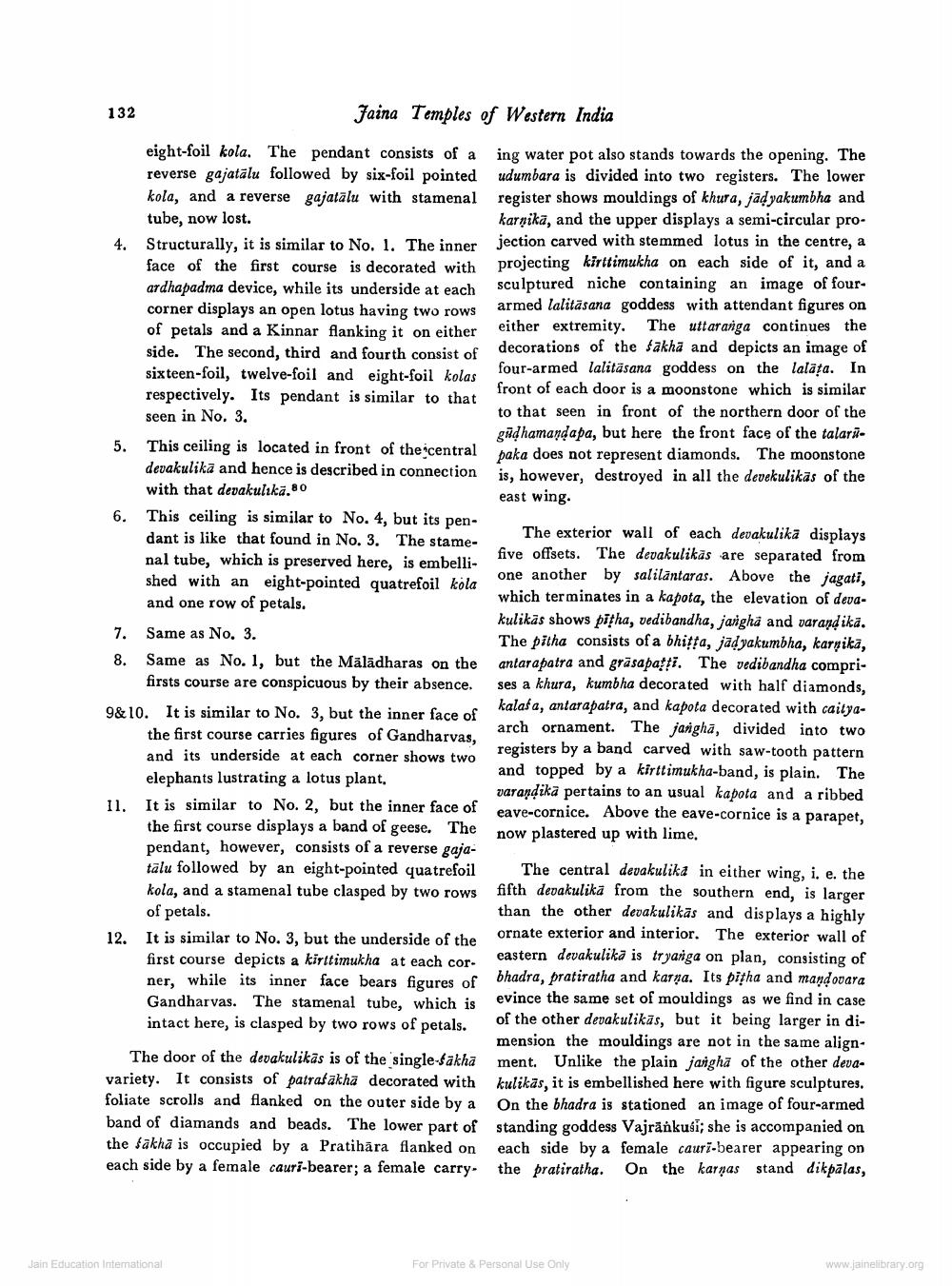________________
132
Faina Temples of Western India
5.
eight-foil kola. The pendant consists of a ing water pot also stands towards the opening. The reverse gajatālu followed by six-foil pointed udumbara is divided into two registers. The lower kola, and a reverse gajatālu with stamenal register shows mouldings of khura, jadyakumbha and tube, now lost.
karnika, and the upper displays a semi-circular pro4. Structurally, it is similar to No. 1. The inner jection carved with stemmed lotus in the centre, a
face of the first course is decorated with projecting kiritimukha on each side of it, and a ardhapadma device, while its underside at each sculptured niche containing an image of fourcorner displays an open lotus having two rows
armed lalitäsana goddess with attendant figures on of petals and a Kinnar flanking it on either either extremity. The uttaranga continues the side. The second, third and fourth consist of
decorations of the fakha and depicts an image of sixteen-foil, twelve-foil and eight-foil kolas
four-armed lalitäsana goddess on the lalața. In respectively. Its pendant is similar to that
front of each door is a moonstone which is similar seen in No. 3.
to that seen in front of the northern door of the
gūdhamandapa, but here the front face of the talariThis ceiling is located in front of the central baka does not represent diamonds. The moonstone devakulikā and hence is described in connection is, however, destroyed in all the devekulikās of the with that devakulikā.80
east wing. This ceiling is similar to No. 4, but its pendant is like that found in No. 3. The stame
The exterior wall of each devakulika displays nal tube, which is preserved here, is embelli
five offsets. The devakulikās are separated from shed with an eight-pointed quatrefoil kola
one another by salilantaras. Above the jagati, and one row of petals.
which terminates in a kapota, the elevation of deva
kulikäs shows pitha, vedibandha, jangha and varandika. 7. Same as No. 3.
The pitha consists of a bhitra, jadyakumbha, karnika, 8. Same as No. 1, but the Maladharas on the antarapatra and gräsapaffi. The vedibandha compri
firsts course are conspicuous by their absence. Ses a khura, kumbha decorated with half diamonds, 9&10. It is similar to No. 3, but the inner face of
kalala, antarapatra, and kapota decorated with caitya
arch ornament. the first course carries figures of Gandharvas,
The jarigha, divided into two and its underside at each corner shows two
registers by a band carved with saw-tooth pattern
and topped by a kirttimukha-band, is plain. The elephants lustrating a lotus plant,
varandika pertains to an usual kapota and a ribbed It is similar to No. 2, but the inner face of eave-cornice. Above the eave-cornice is a parapet, the first course displays a band of geese. The
now plastered up with lime. pendant, however, consists of a reverse gajatālu followed by an eight-pointed quatrefoil The central devakulika in either wing, i. e. the kola, and a stamenal tube clasped by two rows fifth dedakulika from the southern end, is larger of petals.
than the other devakulikās and displays a highly 12. It is similar to No. 3, but the underside of the
ornate exterior and interior. The exterior wall of first course depicts a kiritimukha at each cor.
eastern devakulika is tryaniga on plan, consisting of ner, while its inner face bears figures of bhadra, pratiratha and karna. Its pitha and mandovara Gandharvas. The stamenal tube, which is
evince the same set of mouldings as we find in case
evince the same set intact here, is clasped by two rows of petals.
of the other devakulikās, but it being larger in di
mension the mouldings are not in the same alignThe door of the devakulikās is of the single-sakha ment. Unlike the plain jarigha of the other devavariety. It consists of patrašakha decorated with kulikās, it is embellished here with figure sculptures. foliate scrolls and flanked on the outer side by a On the bhadra is stationed an image of four-armed band of diamands and beads. The lower part of standing goddess Vajränkusi; she is accompanied on the fakha is occupied by a Pratihära flanked on each side by a female cauri-bearer appearing on each side by a female cauri-bearer; a female carry the pratiratha. On the karnas stand dikpālas,
11.
Jain Education International
For Private & Personal Use Only
www.jainelibrary.org




